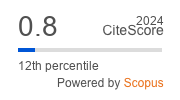High-frequency C–V-characteristics of membrane structures based on Ba1-xSrxTiO3
https://doi.org/10.17073/1609-3577j.met202405.586
Abstract
The production of ferroelectric membrane-type structures was carried out in several sequential operations. First, wells were etched on a silicon (100) n-type plate with a thickness of 250 µm with a natural oxide on the surfaces in a hydrofluoric acid solution of 70 wt.% HF+30 wt.% H2O and a membrane blank was obtained. The diameter of the recesses in the silicon wafer at the base was 1.2 mm. Then, a 300 nm Ba0.8Sr0.2TiO3 layer and contact electrodes were deposited on the flat surface of the membrane blank. The minimum thickness of the n-Si substrate was 20 µm. Comparative measurements of high-frequency C–V-characteristics of metal-ferroelectric-semiconductor objects grown on thin (20 µm) and thick (750 µm) substrates were carried out at room temperature. A change in capacitive properties of samples was found with a decrease in the thickness of the substrate on which they were formed. In objects grown on a thin substrate, compared with those formed on a thick one, branches of the C–V-characteristic are shifted towards negative voltages by 4 V and the width of the hysteresis loop is 3÷4 V larger. A decrease in the "tightness" of the ferroelectric film with a decrease in the thickness of the silicon wafer to 20 microns leads to an increase in the capacitance value of the structure on the plateau of C–V-characteristics by 1.7 times and an expansion of the hysteresis loop by several volts. The observed difference in capacitance values on the plateau indicates that Ba0.8Sr0.2TiO3 contacts with Si are not the same in cases with thin and thick substrates. Shifts in C–V-characteristics along the field voltage axis are most likely associated with different embedded charges at the Ba0.8Sr0.2TiO3 — Si interface for cases with thick and thin substrates.
About the Authors
D. A. BelorusovRussian Federation
1 Vvedenskogo Sq., Fryazino, Moscow Region 141120
Dmitry A. Belorusov — Researcher, Laboratory No. 251
E. I. Goldman
Russian Federation
1 Vvedenskogo Sq., Fryazino, Moscow Region 141120
Evgeniy I. Goldman — Cand. Sci. (Phys.-Math.), Leading Researcher, Laboratory No. 251
M. S. Afanasyev
Russian Federation
1 Vvedenskogo Sq., Fryazino, Moscow Region 141120
Mikhail S. Afanasyev — Dr. Sci. (Eng.), Leading Researcher, Laboratory No. 251
G. V. Chucheva
Russian Federation
1 Vvedenskogo Sq., Fryazino, Moscow Region 141120
Galina V. Chucheva — Dr. Sci. (Phys.-Math.), Chief Researcher, Head of the Laboratory No. 251
References
1. Vorotilov K.A., Mukhortov V.M., Sigov A.S. The Integrated Ferroelectric Devices. M.: Energoatomizdat; 2011. 175 с. (In Russ.)
2. Park J.Y., Yang K., Lee D.H., Kim S.H., Lee Y., Reddy P.R.S., Jones J.L., Park M.H. A perspective on semiconductor devices based on fluorite-structured ferroelectrics from the materials–device integration perspective. Journal of Applied Physics. 2020; 128(240904):1-24. https://doi.org/10.1063/5.0035542
3. Wang B., Huang W., Chi L., Al-Hashimi M., Marks T.J., Facchetti A. High-k Gate Dielectrics for Emerging Flexible and Stretchable Electronics. Chemical Reviews. 2018; 118(11):5690−5754. https://doi.org/10.1021/acs.chemrev.8b00045
4. Du D., Hu J., Kawasaki J.K. Strain and strain gradient engineering in membranes of quantum materials. Applied Physics Letters. 2023; 122(170501):1 – 9. https://doi.org/10.1063/5.0146553
5. Zhang K., Ren Y., Cao Y. Mechanically tunable elastic modulus of freestanding Ba1_xSrxTiO3 membranes via phase-field simulation. Applied Physics Letters. 2022; 121(152902):1-5. https://doi.org/10.1063/5.0099772
6. Ko D.L., Tsai M.F., Chen J.W., Shao P.W., Tan Y.Z., Wang J.J., Ho S.Z., Lai Y.H., Chueh Y.L., Chen Y.C., Tsai D.P., Chen L-Q., Chu Y.H. Mechanically controllable nonlinear dielectrics. Science Advances. 2020; 6(10): 1-11. https://doi.org/10.1126/sciadv.aaz3180
7. Xu R., Huang J., Barnard E.S., Hong S.S., Singh P., Wong E.K., Jansen T., Harbola V., Xiao J., Wang B.Y., Crossley S., Lu D., Liu S., Hwang H.Y. Strain-induced room-temperature ferroelectricity in SrTiO3 membranes. Nature Communications. 2020; 11(3141):1-8. https://doi.org/10.1038/s41467-020-16912-3
8. Wang B., Lu H., Bark C.W., Eom C-B., Gruverman A., Chen L-Q. Mechanically Induced Ferroelectric Switching in BaTiO3 Thin Films. Acta Materialia. 2020; 193(7):151-162. https://doi.org/10.1016/j.actamat.2020.04.032
9. Ivanov M.S., Afanas’ev M.S. Specific Features of the Formation of BaxSr1–xTiO3 Ferroelectric Thin Films on Different Substrates by Radio-Frequency Sputtering. Physics of the Solid State. 2009; 51(7):1328–1331. https://doi.org/10.1134/S1063783409070026
10. Kiselev D.A., Afanasiev M.S., Levashov S.A., Chucheva G.V. Growth Kinetics of Induced Domains in Ba0.8Sr0.2TiO3 Ferroelectric Thin Films. Physics of the Solid State. 2015; 57(6):1151–1154. https://doi.org/10.1134/S1063783415060189
11. Belorusov D.A., Goldman E.I., Chucheva G.V. On the form of high-frequency voltage-capacitance characteristics of metal-insulator-semiconductor structures with a ferroelectric insulating layer BaxSr1-хTiO3. Ceramics International. 2021; 47(15):21248-21252. https://doi.org/10.1016/j.ceramint.2021.04.129
12. Belorusov D.A., Goldman E.I., Chucheva G.V. The role of а buffer layer at the contact with silicon in structures with an insulating gap made of a material replacing SiO2. Ceramics International. 2024; 50(6):9678-9681. https://doi.org/10.1016/j.ceramint.2023.12.286
Review
For citations:
Belorusov D.A., Goldman E.I., Afanasyev M.S., Chucheva G.V. High-frequency C–V-characteristics of membrane structures based on Ba1-xSrxTiO3. Izvestiya Vysshikh Uchebnykh Zavedenii. Materialy Elektronnoi Tekhniki = Materials of Electronics Engineering. 2024;27(3):278-282. (In Russ.) https://doi.org/10.17073/1609-3577j.met202405.586





































